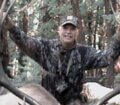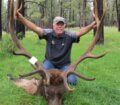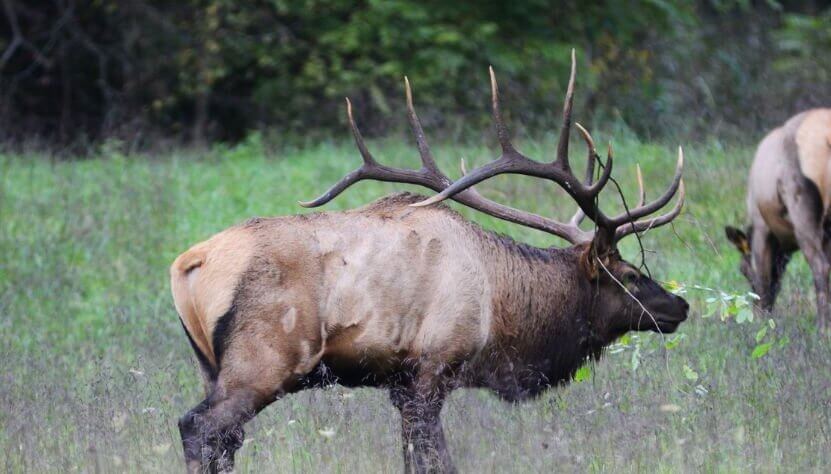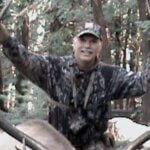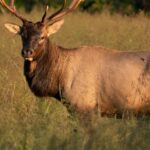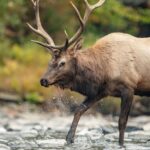Editor’s Note: Mark Hanson, from Mesa, Arizona, has a severe case of elk addiction. Mark took his first bull in 1984 with a bow—a spike with brow tines (a legal bull)—that really hooked him on elk hunting. Since then, he’s taken many bulls with his bow and two in Colorado with a rifle. However, he’s called in numerous bulls for friends and family members – about 100+ bulls. When Hanson isn’t hunting bull elk to take for himself, he hunts with friends and relatives yearly to help record their hunts, find bulls for them, call bull elk, and carry out the meat.
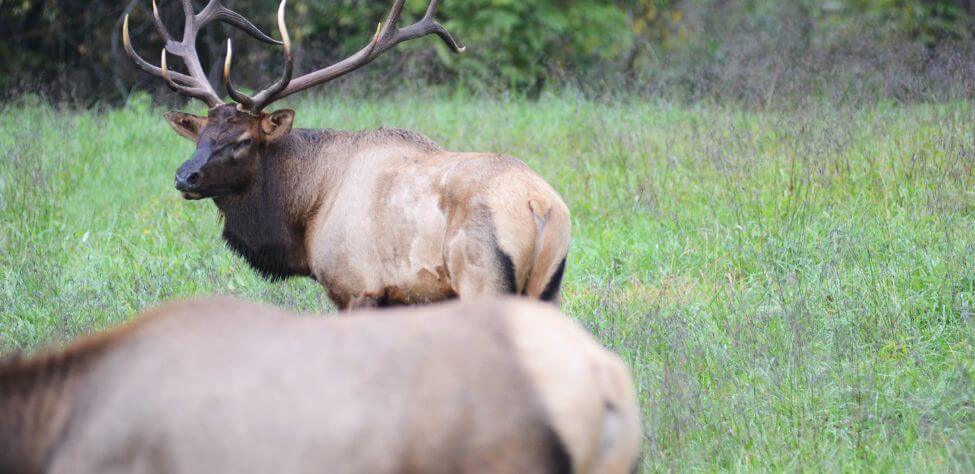
On this hunt, I had Tom Smith and my stepson, Ron Gonzalez, who was 40 years old at the time, with me hunting elk. Tom and I had hunted elk together off and on for several years. We had driven up on top of a ridge, walked a little way, and heard a bullbugle down in the canyon. Neither Ron nor Tom had an elk tag. They had come on the hunt with me just to help me try to get a bull and to help me carry the meat out. All the people I hunt with really enjoy elk hunting. Whether we have tags or not, we all volunteer to go with each other on elk hunts just to be on the hunts and help with the heavy lifting.
Over the years, I’ve learned that the more friends you have who will hunt with you, or come to where you’ve got an elk down and help you get the bull back to your vehicle, the quicker the job of butchering and carrying out meat is. Then the hunt is more fun for everyone. Once we heard this bull down in the canyon, I started cow-calling to him, and he answered me. I told Tom and Ron to sit down on the side of this mountain, and I planned to go over a little hump and be about 15 yards below them. I thought the bull would come in below us. Ron was sitting about 10 yards away, and Tom was about another 5 yards to his right.
Tom’s hearing isn’t good, and I joke with him about that. I listened to the bull as he was coming up the mountain, and I was cow calling to him. The bull was about 150 yards from me, closing ground, when I felt someone tap my shoulder. I looked back and saw Tom, who asked, “Are you hearing anything?” I told Tom, “He’s close; get back to where I’ve left you.”

As the bull closed the distance, I could tell he was coming up the ridge behind Tom. When I saw the bull, he was only about 27 yards from me and maybe 10 yards from Tom and Ron. Once the bull had cleared Tom and Ron, I shot. Later, Ron said, “I heard the arrow fly past us,” and Tom said, “I saw the arrow go past me. I couldn’t hear it, but I could sure see it.” I believe my arrow flew only about 4 feet before Tom’s face. I hit the bull right behind the shoulder, and the broadhead stuck in the opposite shoulder. When the bull felt the arrow, he only went about 30 yards, stopped, and then dropped dead. Because I was below Tom and Ron, I didn’t see the bull go down, but Tom could watch him fall. We all stayed where we were for about 20 minutes before we went to the bull.
After we looked at the bull and celebrated, Ron returned to camp to get our packs and butchering equipment, and we skinned the elk. I don’t field-dress elk anymore. I just get the four quarters off, remove the two backstraps, go between the ribs, and get both tenderloins. We used a saw on a couple of ribs close to the heart and took the liver out of the elk. After we took off the cape and disconnected the head, we deboned the neck for hamburger meat.

Ron saw two guys we’d met on previous hunts, and they got in the truck with their equipment and returned to where the elk was. So, we had five people to help get the elk out. We only had to make one trip to pack all the meat and then head back to the truck. The other good news about this hunt was we had left our truck about 500 yards downhill from where the elk had gone down, so we had a relatively easy hike to carry the meat out. This was a great, big, monstrous bull elk and one of the most accessible elk hunts ever.
On this trip, I learned:
- You don’t always know which way the elk will come from before he’s within shooting range. I had to turn all the way around to get my shot off.
- A partner with a hearing impairment needs a sound amplifier that doesn’t cost much, instead of an expensive hearing aid. Tom couldn’t hear very well, and he might’ve spooked the elk if the bull had been closer to me than he was when Tom tapped me on the shoulder and
- If you ask, the people camped near you will often help you cut up your meat and get your elk out of the woods. We always help anyone carry a bull out.
Expert Guidebooks on Elk Hunting: Best Sellers

Secrets for Hunting Elk
The quickest, easiest (if there is an easy way), and safest way to find and take that bull elk of a lifetime will be to hunt with a guide.
Chad Schearer, a longtime Montana guide and TV personality, told me, “My hunter is my gun. If I get to the elk, and my hunter isn’t with me, then we don’t take the elk. My job is not only to find the elk but also to help the hunter get to the elk and make the experience as enjoyable as I can for him.” That’s the kind of fella with whom I want to go elk hunting.
An elk hunt can be tough, but it doesn’t have to be so tough that you don’t enjoy it. That’s why this elk hunting book starts with the confessions of an elk guide and with Chad Schearer’s philosophy of what the guide and the hunter’s relationship should be.
A good portion of your success will depend on your physical condition, and Matt Morrett of Harrisburg, Pennsylvania explains how an eastern hunter can get ready physically during June and July to hunt western elk, the animals he describes as, “Like deer or turkeys on steroids.”
Wayne Carlton, well-known elk hunter and TV and video personality from Montrose, Colorado, tells us what types of elk calls to use and what to say to the elk. Mike Miller of Colorado, another elk guide and Mossy Oak video personality, has tactics for the best equipment for bowhunting and gun hunting elk.
You’ll learn helpful strategies and hunting tips in this book, as well as some straightforward hunting methods that will help to make your elk hunt more successful.
“Thanks to the advice in your elk hunting books, I was able to call up a nice 6-point (6X6) bull elk! He was bugling like crazy. I called him in from about a ¼ mile away. Called him into bow range (about 40 yards away). It was a thrill!” ~Rob Brannon
VERSIONS: AUDIBLE & KINDLE

Elk: Keys to 25 Hunters’ Success
Often just one tip or tactic makes the difference in whether you take an elk home to dinner or have to hike back to the truck by yourself. In John E. Phillips’ latest elk book, Elk: Keys to 25 Hunters’ Success, you’ll learn from successful elk hunters the strategies they use to find and take elk.
Many know that the technique that seems to work most often is to hunt where other elk hunters don’t and understand where the elk are before you go on a hunt by studying data from each state, visiting HuntData (see chapter 1), examining maps, and reading postings on elk forums.
This book also tells you how to get ready physically for an elk hunt, including participating in Train to Hunt Competitions, what gear you need to take, how to enjoy a successful do-it-yourself elk hunt, or how to pick the best elk guide for you. You’ll also hear about the X System and the Broken Y System of hunting elk.
Although no one person has all the answers on how to help you find and take your elk, I’m convinced that this book’s outdoors men and women will teach you how to have satisfying elk hunts.
As my friend Karl Badger once told me, “Elk hunting doesn’t get any better than when I ride horses into the high backcountry, see two grizzly bears, hear a pack of wolves howl close to camp all night long, eat plenty of delicious food prepared on a fire and enjoy the company of good friends.”
VERSIONS: AUDIBLE, KINDLE & PRINT

How to Find Your Elk and Get Him in Close will teach you the tactics of 10 nationally known elk hunters, to help put that giant bull that’s been screaming at you from afar, in your lap. You’ll learn what some of the best guides, outfitters, and successful elk hunters do to find elk and get them in really close.
Also in this audiobook, you’ll notice that the majority of the experts call elk to within bow range. We selected numerous bowhunters and bowhunting guides, since the bowhunter has to get much closer to a bull than the gun hunter does – often less than 20 or 30 yards – practically in your lap.
On one elk hunt, I’d heard this bull bugle all morning. My guide had called him within 30 yards, and he was standing just inside black timber. I saw the smoke from his nose wafting out into the icy air less than 30-yards away. All the bull had to do was step out, and I could take the shot with my bow. But then, through no fault of my guide or me, the bull vanished.
The only conclusion I could come up with to understand why the bull I wanted to take with my bow hadn’t stepped out and given me a shot, was because he got raptured. He evidently had left the earth with no trace of himself.
This hunt was when I started wanting to learn more about hunting elk up close. In this book, I’ve tried to find some of the most knowledgeable, experienced, and practical elk hunters. I’ve always found that the best way to learn any outdoor skill, is to either hunt or fish with the best sportsmen in that field.
Often, in elk hunting, that means elk guides, who generally hunt every day of the season and receive a salary for every hunter they guide. So, I’ve put together a group of some of the best elk hunters I know to help us all learn how to find bull elk and get them in close.
VERSIONS: AUDIBLE, KINDLE & PRINT
Tomorrow: Learning from a Bull Elk

